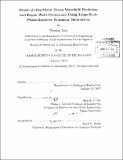| dc.contributor.advisor | Dick K. P. Yue. | en_US |
| dc.contributor.author | Xiao, Wenting, 1982- | en_US |
| dc.contributor.other | Massachusetts Institute of Technology. Department of Mechanical Engineering. | en_US |
| dc.date.accessioned | 2013-06-17T19:56:42Z | |
| dc.date.available | 2013-06-17T19:56:42Z | |
| dc.date.copyright | 2013 | en_US |
| dc.date.issued | 2013 | en_US |
| dc.identifier.uri | http://hdl.handle.net/1721.1/79330 | |
| dc.description | Thesis (Ph. D.)--Massachusetts Institute of Technology, Dept. of Mechanical Engineering, 2013. | en_US |
| dc.description | Cataloged from PDF version of thesis. | en_US |
| dc.description | Includes bibliographical references (p. 257-267). | en_US |
| dc.description.abstract | It is challenging to obtain accurate predictions of ocean surface wavefield evolutions due to several complex dynamic processes involved, including nonlinear wave interaction, wave breaking and wind forcing, and also wave interactions with currents and bottom bathymetry. With fast computational algorithms for nonlinear phase-resolved wave simulations and modern computational capabilities, we now develop and apply a direct large-scale nonlinear phase-resolved wavefield simulation tool, which we call SNOW (Simulation of Nonlinear Ocean Wavefields), to study the evolution of directional ocean waves and occurrence of rogue waves (extremely large waves). Using SNOW, we obtain an ensemble of nonlinear deep-water wavefield simulations, initialized by JONSWAP spectrum with a broad range of spectral parameters, over large space-time scales. Spectral evolutions, nonlinear wave statistics and rogue wave occurrence are investigated based on the simulated wavefields. The SNOW results are compared to available wave basin experiments and predictions from linear theory and approximate nonlinear-Schr6dinger-equation (NLS) type models. SNOW predictions give an overall better comparison with wave-basin experiments than NLStype model predictions. For initially narrow-banded and narrow-directional-spreading wavefields, we find modulational instability develops over short time, resulting in considerable spectral broadening, strongly non-Gaussian statistics and probability of rogue wave occurrence an order of magnitude higher than linear theory prediction. For longer time, the wave spectrum in SNOW simulations reaches a non-Gaussian quasi-stationary state, and this is not predicted by NLS-type models, where a continuous spectral broadening is observed. When waves spread broadly in frequency and direction, the modulational-instability effect is reduced and the wave statistics and rogue wave probability are close to linear theory prediction. Number and area-based probabilities are introduced to measure the likelihood of rogue wave occurrence. To effectively predict rogue wave occurrence in directional seas, we propose a new modified Benjamin-Feir index (MBFI), which accounts for the effects of wave directionality. It is shown that the occurrence probabilities of rogue waves are well correlated with MBFI over a broad range of spectral parameters. Based on a large catalogue of rogue waves found from SNOW simulations, the geometric shapes of rogue waves are analyzed using proper orthogonal decomposition (POD). It is found that rogue wave profiles can generally be described by a small number of POD modes. SNOW simulations are also used to investigate the influence of finite depth on the evolution of nonlinear wavefields. As water depth decreases, the modulational instability decreases and finally diminishes. It is found that the occurrence probability of rogue waves and wave kurtosis decrease as water depth decreases. The wave statistics and rogue wave occurrence in bimodal wavefields are also studied. The influence of swell on the wave statistics of single-modal wind sea is not monotonic. The occurrence probability of rogue waves can either increase or decrease depending on the bimodal spectrum shape. We find the rogue wave probability and wave kurtosis are minimized when the propagation directions of swell and wind sea are orthogonal. By assimilating wave measurements from in-situ buoy and/or remote sensing into SNOW, we develop and demonstrate the capability of phase-resolved reconstruction and forecasting of wavefield evolution and rogue wave occurrence. Such capability could significantly enhance marine design and operation. This research paves the way for a new-generation wave forecasting model that is capable of providing heretofore unavailable large-scale phase-resolved information on the ocean wave evolution. Such capability is critically useful such as in the understanding of rogue wave dynamics and in the practical marine operations and safety. | en_US |
| dc.description.statementofresponsibility | by Wenting Xiao. | en_US |
| dc.format.extent | 267 p. | en_US |
| dc.language.iso | eng | en_US |
| dc.publisher | Massachusetts Institute of Technology | en_US |
| dc.rights | M.I.T. theses are protected by
copyright. They may be viewed from this source for any purpose, but
reproduction or distribution in any format is prohibited without written
permission. See provided URL for inquiries about permission. | en_US |
| dc.rights.uri | http://dspace.mit.edu/handle/1721.1/7582 | en_US |
| dc.subject | Mechanical Engineering. | en_US |
| dc.title | Study of directional ocean wavefield evolution and rogue wave occurrence using large-scale phase-resolved nonlinear simulations | en_US |
| dc.type | Thesis | en_US |
| dc.description.degree | Ph.D. | en_US |
| dc.contributor.department | Massachusetts Institute of Technology. Department of Mechanical Engineering | |
| dc.identifier.oclc | 846904804 | en_US |
